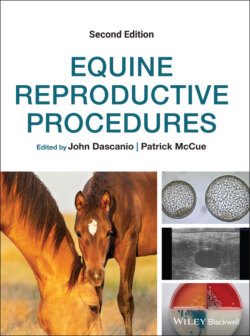Читать книгу Equine Reproductive Procedures - Группа авторов - Страница 56
Introduction
ОглавлениеIn every cell, the genetic material, DNA, is packaged with the help of diverse proteins into distinct structures – the chromosomes. Chromosomes are located in the cell nucleus and show species‐specific features in number, size, and appearance. The chromosome complement of a cell of a species is called the karyotype and the field of science studying the chromosomes is cytogenetics.
The diploid (2n) chromosome number for the normal horse is 64 and includes 31 pairs of autosomes and a pair of sex chromosomes. Female horses have two X chromosomes and male horses have one X and one Y chromosome. Thus, normal female and male horse karyotypes are denoted as 64,XX and 64,XY, respectively. Half of chromosomes are inherited from the sire, the other half from the dam.
Changes in chromosome number and morphology directly affect the viability of zygotes and embryos, normal development, and the formation of gametes. Changes in the number of autosomes such as trisomies are typically lethal, but if present in live‐born foals are accompanied by multiple and severe congenital malformations and primary infertility. Structural rearrangements of chromosomes, known as translocations, may have only a mild effect on the carrier, but can significantly affect both male and female fertility. Abnormal number or structure of sex chromosomes can cause infertility and/or disorders of sexual development (Raudsepp & Chowdhary 2016).
The aim of clinical chromosome analysis is to determine whether or not a horse has a normal set of chromosomes. The analysis is usually carried out on animals with various reproductive and/or developmental disorders to ascertain possible causes of abnormalities. Additionally, cytogenetic tests are ordered by insurance companies, horse breeders, and owners to evaluate potential breeding stallions, broodmares, or the horses to be purchased. A more recent addition to equine clinical cytogenetics is the evaluation of chromosomal stability in stem cell lines that are produced for stem cell therapy.
Chromosomal analysis includes counting the diploid (2n) chromosome number, arranging chromosomes into a karyotype, and evaluating chromosome morphology according to their banding patterns following the international system of chromosomal nomenclature for the horse (ISCNH) (Bowling et al. 1997). The analysis also determines whether or not the chromosomal (genetic) sex agrees with the gonadal and phenotypic sex.
This chapter describes the methods that are used for clinical cytogenetic analysis in horses. This includes a list of the basic required equipment and supplies for an equine cytogenetics laboratory, a detailed step‐wise methodology for the preparation of metaphase chromosome spreads from different tissues, and a description of the main principles and methods of chromosome analysis. Finally, advanced chromosome analysis approaches and future perspectives of equine clinical cytogenetics are briefly discussed.
